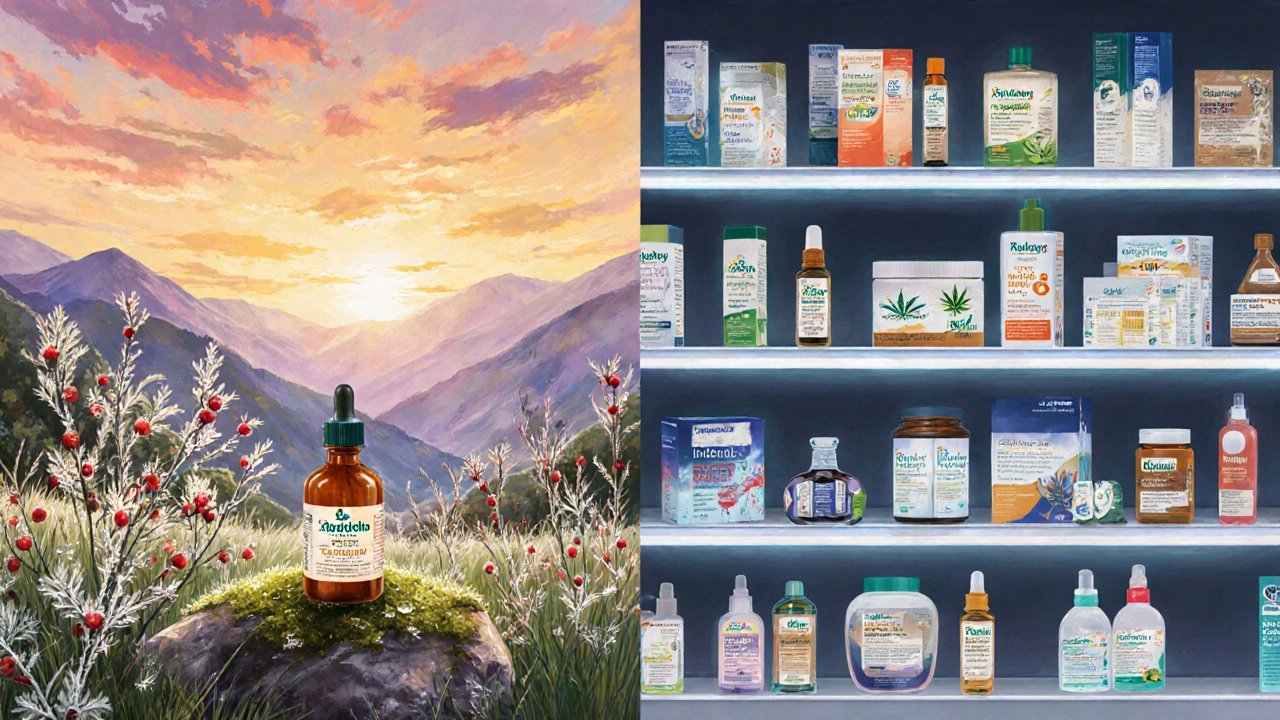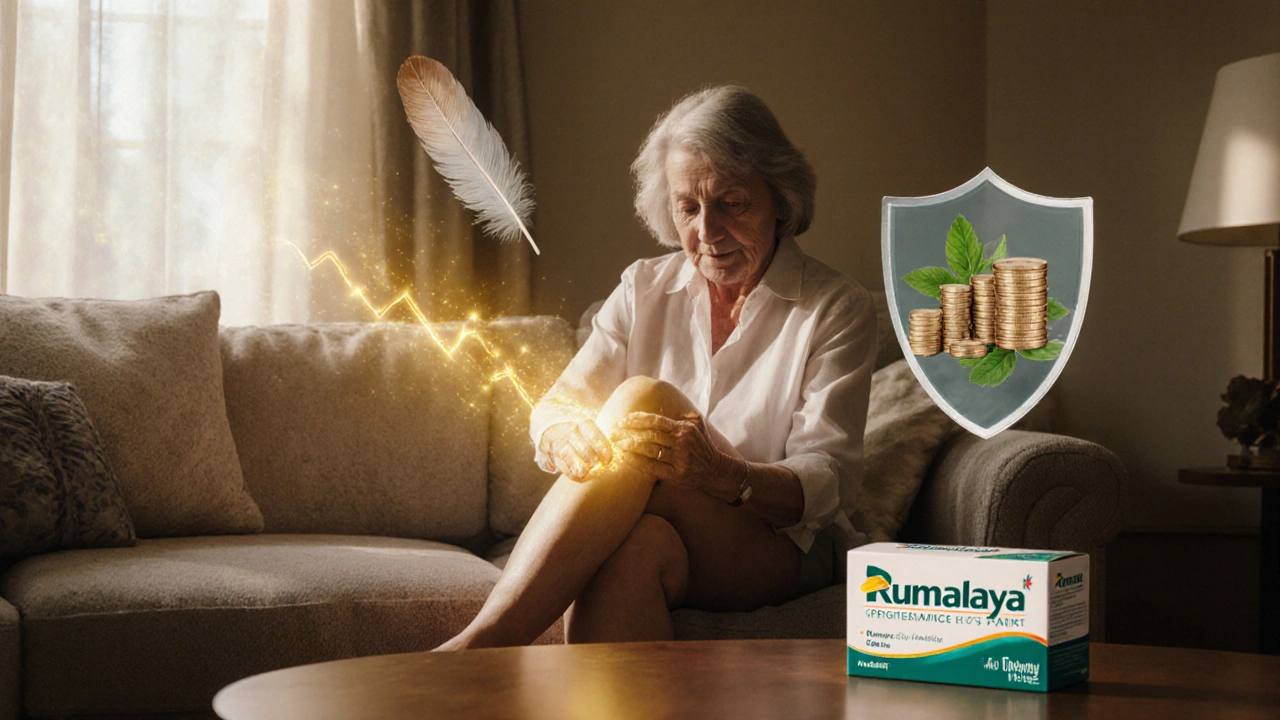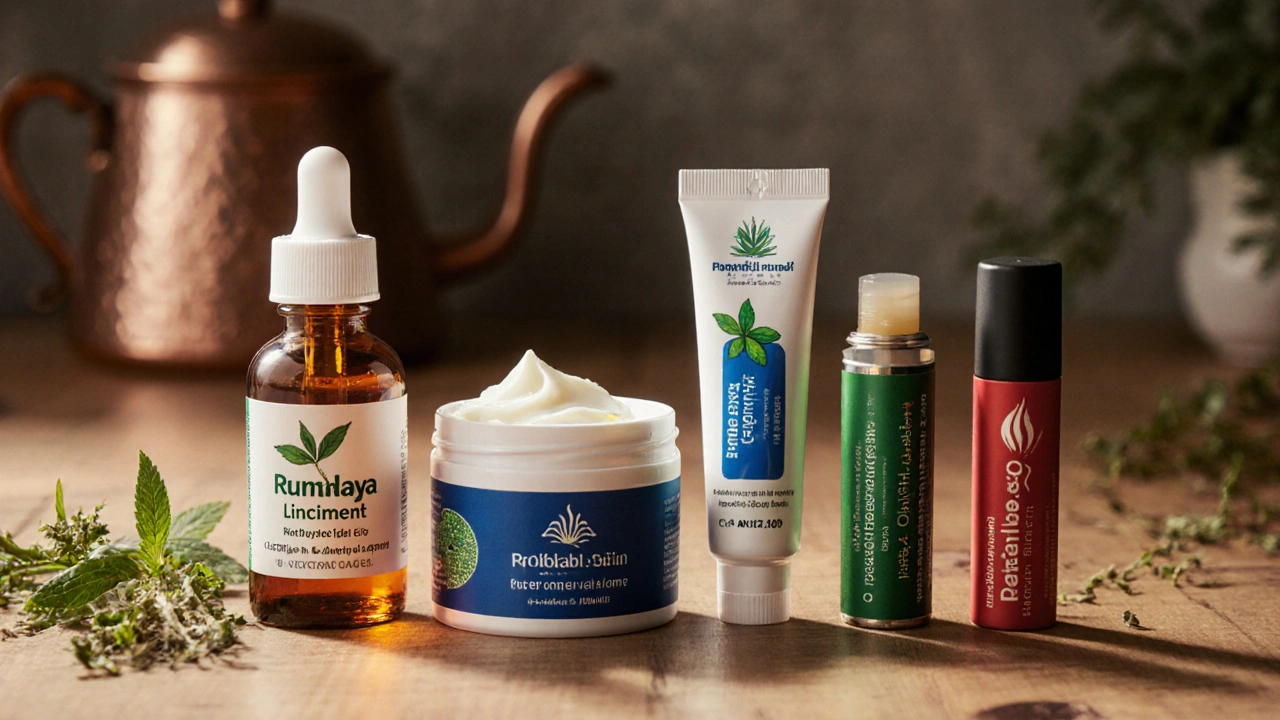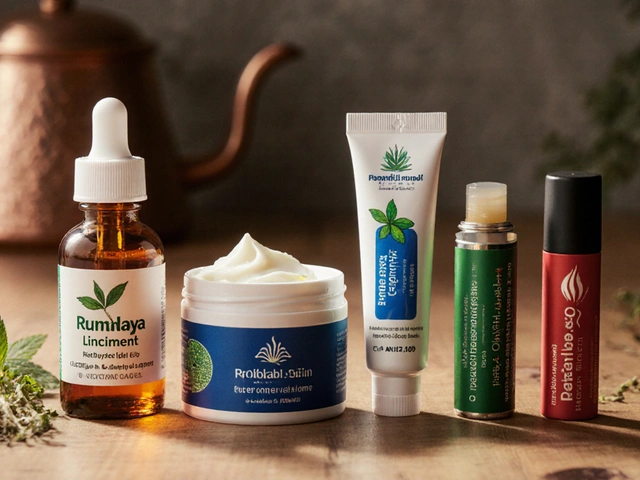When it comes to soothing sore muscles and joint aches, many Australians reach for a cheap ointment without checking if it actually works. Rumalaya liniment claims to stand out thanks to its Gaultheria (wintergreen) extract, but how does it stack up against the market’s heavy‑hitters? This guide breaks down the science, the scent, and the price of Rumalaya and five popular alternatives, so you can pick the right bottle for your next workout recovery or back‑pain night.
TL;DR - Quick Takeaways
- Rumalaya uses natural Gaultheria oil, delivering a strong menthol burn that eases muscle tension without synthetic chemicals.
- Tiger Balm provides a balanced blend of menthol and camphor, great for fast‑acting relief but can feel intense on sensitive skin.
- Arnica gel offers anti‑inflammatory plant compounds; it’s milder but slower to work.
- Capsaicin patches deliver a long‑lasting heat effect, ideal for chronic joint pain but may cause a burning sensation.
- Ibuprofen gel combines NSAID power with a topical base, offering the strongest pain knock‑down but carries the risk of systemic side effects.
What is Rumalaya Liniment?
Rumalaya liniment is a topical analgesic made from the essential oil of Gaultheria procumbens (wintergreen), blended with a botanical carrier of eucalyptus, rosemary, and peppermint. Launched in 2018 by an Australian family‑owned brand, Rumalaya markets itself as a natural, non‑synthetic option for athletes, manual workers, and anyone dealing with everyday aches.
The key active component is methyl salicylate, a naturally occurring salicylate that mimics the action of aspirin without entering the bloodstream in significant amounts. Users report a rapid cooling‑then‑warming sensation that penetrates deep into muscle tissue within five minutes.
How Gaultheria (Wintergreen) Works
Gaultheria procumbens is a low‑lying shrub native to North America, whose berries and leaves are rich in methyl salicylate. When applied topically, the compound blocks the cyclooxygenase pathway locally, reducing the production of prostaglandins that signal pain.
Because the oil is delivered through a fatty carrier, it stays on the skin longer than pure menthol sprays, allowing a sustained analgesic effect. The plant also contains minor amounts of flavonoids that act as antioxidants, potentially aiding tissue repair after minor strains.
Top Alternatives on the Australian Market
Tiger Balm Classic
Tiger Balm is a heritage brand from Singapore, known for its red (hot) and white (cool) balms. The formulation mixes menthol, camphor, cajeput oil, and clove oil, creating a sharp, tingling heat that boosts blood flow. While effective for acute sprains, the high camphor content can irritate sensitive skin.
Arnica Gel
Arnica gel utilizes the flower of Arnica montana, a Swiss alpine plant rich in sesquiterpene lactones. These compounds have anti‑inflammatory properties, making the gel a gentler option for bruises and post‑exercise soreness. The gel base allows quick absorption, but the relief onset is slower (15‑30 minutes) compared to menthol‑rich products.
Menthol Cream (Pure Menthol Labs)
Menthol cream from Pure Menthol Labs offers 10% pure menthol in a petroleum‑free base. It delivers an intense cooling sensation and is often used by runners for shin splints. Without additional anti‑inflammatory agents, it mainly masks pain rather than treating underlying inflammation.
Capsaicin Patch (Lidocaine‑Free)
Capsaicin patch contains 8% capsaicin extracted from hot peppers, applied for 30‑60 minutes to achieve prolonged desensitization of pain receptors. Ideal for chronic osteoarthritis, it can cause a burning sensation during the first few applications, but the effect lasts up to 12 hours.
Ibuprofen Gel
Ibuprofen gel combines the NSAID ibuprofen with a hydrogel carrier, providing up to 400mg of drug per application. Clinical trials show it reduces joint pain as effectively as oral ibuprofen, with fewer gastrointestinal side effects, though systemic absorption still occurs.
Side‑by‑Side Comparison Table
| Product | Active Ingredient(s) | Onset of Relief | Duration | Skin Sensitivity | Price (AU$ per 100ml) |
|---|---|---|---|---|---|
| Rumalaya | Gaultheria (methylsalicylate) + eucalyptus | 5min | 2‑3hrs | Low‑moderate | 22 |
| Tiger Balm | Menthol + camphor | 2‑5min | 1‑2hrs | Moderate‑high | 15 |
| Arnica Gel | Arnica montana extract | 15‑30min | 2‑4hrs | Low | 18 |
| Menthol Cream | Pure menthol 10% | 3‑5min | 1‑2hrs | Moderate | 12 |
| Capsaicin Patch | Capsaicin 8% | 30‑60min (after first use) | 8‑12hrs | High (burning) | 35 |
| Ibuprofen Gel | Ibuprofen 400mg per dose | 10‑15min | 4‑6hrs | Low‑moderate | 28 |

Choosing the Right Liniment for Your Needs
Here’s a quick decision matrix you can run in your head:
- Need fast, intense relief for a fresh strain? Reach for Rumalaya or Tiger Balm-both kick in under five minutes.
- Prefer a gentle, plant‑based approach? Arnica gel or Rumalaya (which is also plant‑derived) are low‑irritation choices.
- Managing chronic joint pain? Capsaicin patches give hours of desensitization, while Ibuprofen gel targets inflammation more directly.
- Worried about synthetic chemicals? Rumalaya, Arnica, and pure menthol cream keep the ingredient list short and natural.
- Budget‑tight? Tiger Balm and Menthol cream are the cheapest per 100ml, but they may need more frequent re‑applications.
Always test a small skin area first, especially with high‑camphor or capsaicin products. If you notice redness, itching, or a burning sensation that lasts beyond the product’s claimed duration, rinse off and switch to a milder option.
Potential Pitfalls and How to Avoid Them
- Mixing products. Applying two menthol‑heavy liniments on top of each other can overwhelm nerve endings, leading to numbness.
- Overuse on broken skin. All topical analgesics should be avoided on open wounds; they can irritate and delay healing.
- Systemic absorption. NSAID gels (Ibuprofen) and high‑dose methyl salicylate (Rumalaya) can enter the bloodstream if used over large areas. Follow the recommended 4g per application limit.
- Pregnancy considerations. Consult a physician before using any salicylate‑based liniment, as methyl salicylate crosses the placenta.
Where to Buy and What to Look for on the Label
Most of these products are available at major pharmacies (ChemistWarehouse, Priceline) and online marketplaces (Amazon AU, eBay). When checking a label, verify the following:
- Exact concentration of the active ingredient (e.g., 5% methyl salicylate for Rumalaya). \n
- Presence of any synthetic fragrances or parabens-these can trigger allergies.
- Expiry date; essential oils degrade over time, reducing efficacy.
For Rumalaya, look for the “Gaultheriaprocumbensoil≥4%” claim; lower percentages may indicate a diluted product.
Bottom Line - Is Rumalaya Worth It?
If you prioritize a natural ingredient list and want a balance of quick onset with moderate duration, Rumalaya holds its own against the market leaders. It’s pricier than Tiger Balm but gentler on sensitive skin, and it delivers the same methyl salicylate punch without added camphor. For athletes who need a reliable, plant‑based solution, it’s a solid pick. If you need either the strongest anti‑inflammatory power (Ibuprofen gel) or long‑lasting heat (Capsaicin patch), those alternatives remain superior.
Frequently Asked Questions
Can I use Rumalaya on my face?
Rumalaya is formulated for muscle and joint areas, not the thin skin on the face. The menthol concentration can cause a stinging sensation around the eyes. Stick to the neck, shoulders, and limbs.
How often can I re‑apply Rumalaya?
The label recommends no more than four grams per application and a maximum of three applications per day. Over‑use can increase systemic methyl salicylate absorption, which may lead to mild stomach upset.
Is Rumalaya safe for children?
For kids under 12, use only a pea‑size amount and avoid the chest and abdomen. Consult a paediatrician if your child has asthma, as menthol can trigger bronchospasm.
Does Rumalaya work for chronic arthritis?
It can provide temporary relief, but the anti‑inflammatory effect is modest compared to NSAID gels. Pair it with physiotherapy or consult a rheumatologist for a comprehensive plan.
What’s the main difference between Rumalaya and Tiger Balm?
Rumalaya relies mainly on Gaultheria‑derived methyl salicylate, while Tiger Balm mixes menthol with camphor and clove oil. The latter gives a hotter burn but can be harsher on sensitive skin.

Next Steps
1. Identify the type of pain you’re treating (acute vs. chronic, surface vs. deep).
2. Choose a product that matches the onset‑duration profile you need.
3. Purchase from a reputable retailer and check the concentration label.
4. Test a small area for 24hours before full‑application.
5. Keep a short symptom diary to see which liniment gives the best relief.
With the right information, you can skip the guesswork and pick a liniment that actually works for you.



Katherine Stapp
September 29, 2025 at 15:24OMG I tried Rumalaya after my yoga class and my back felt like it was being hugged by a dragon 🐉🔥 Like, I could feel the methyl salicylate working through my jeans. Tiger Balm? Pfft. That’s for people who think ‘natural’ means ‘has a label that says organic.’ This is witchcraft. And I love it.
Frank De Silva
September 29, 2025 at 16:17The entire premise of this article is laughably reductionist. You’re equating a traditional Ayurvedic formulation with over-the-counter chemist’s concoctions as if they occupy the same ontological plane. Methyl salicylate isn’t ‘natural’-it’s a semi-synthetic derivative isolated via industrial extraction. The romanticization of ‘botanical carriers’ is a marketing fiction peddled to the gullible. And don’t get me started on the ‘Australian family-owned brand’ mythos-registered in Delaware, I presume?
KJ Miller
September 30, 2025 at 10:42Honestly, this was super helpful. I’ve been using Tiger Balm for years but always felt like it was too harsh on my wrists. Rumalaya sounds like the Goldilocks zone-strong enough to work, gentle enough not to make me cry. Also, the arnica gel recommendation? That’s my grandma’s remedy. She swears by it for bruising after falls. Maybe we’re not so far from old-school wisdom after all. 🙏
Claire Battista
October 1, 2025 at 07:23I appreciate how you broke this down without pushing one product over another. I’m 42, a nurse, and I’ve tried them all. Capsaicin patches? I still can’t use them without crying. But Rumalaya? I keep a bottle in my bag. Doesn’t smell like a gas station air freshener, doesn’t sting like acid, and actually helps my lower back after 12-hour shifts. Small wins, you know?
Erin DeGroot
October 2, 2025 at 03:05I found it fascinating how the article clarified the distinction between masking pain and reducing inflammation. Many people don’t realize that menthol primarily acts as a counterirritant-it doesn’t heal, it distracts. Meanwhile, methyl salicylate and ibuprofen gel actually interfere with prostaglandin synthesis. That’s not just relief-it’s pharmacology. And yes, I did check the clinical trials. The data is solid.
Stephanie Bryant
October 2, 2025 at 06:35just tried rumalaya after reading this and omg it’s like a cold hug 😍 my knee stopped screaming after 5 mins. i used to use the menthol cream but it dried my skin like crazy. this one? smells like forest and my grandma’s kitchen. also, check the bottle-i got one with 3.8% gaultheria and it was weak. look for the 4%+ on the label! 💯
Drashti patel
October 2, 2025 at 21:50In India, we’ve used wintergreen oil for generations-not as a fancy liniment, but as a drop in warm coconut oil for joint pain. The science here is beautiful, but I wonder if we’ve lost something by turning ancestral remedies into branded products. Is the ritual gone? The slow massage? The quiet moment before the burn? Maybe the real remedy isn’t the oil-it’s the intention behind applying it. Just saying.
Kaitlin Crockett
October 3, 2025 at 18:33I’ve been using Rumalaya for six months now. My shoulder pain from typing all day is way better. No more ibuprofen pills. Just a little dab. I didn’t know about the 4g limit though-good catch.